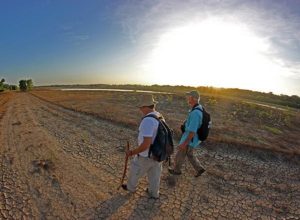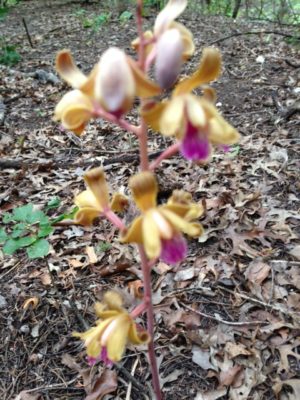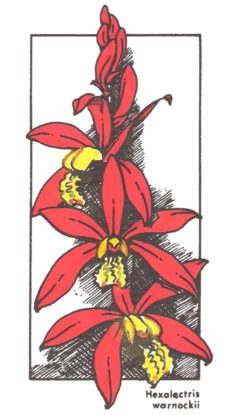
Citizen scientists lead the way to conservation of orchids and other native species
All too often when we talk about orchid conservation we think of exotic locations such as Indonesia or the rain forests around the Amazon in Brazil. I would be willing to bet that Dallas, Texas would not be the first location to pop into someone’s head when the subject of native orchids comes up. However, a little open-mindedness might be in order here, at least that was true in my case.
2015 was a very educational year for me. Not only did I have the opportunity to discover the amazing nature parks around Dallas, I also found an orchid society I had never even heard of. Yes, that’s right. Did you know there is a Hexalextris Orchid Society here in Dallas, and it has been in existence for at least 10 years? It doesn’t have a formal membership list, but rather consists of a group of volunteers that meets every June to survey the park trails of Dallas two times a week for two months, during which the participants record, mark, and measure each orchid discovery.

Hiking the flood scoured Lower Chain of Wetlands Dallas 7/11/15 near Joppa with two Dallas Master Naturalists Richard and Bill
The beauty of this operation is that anyone can participate in what are called “Citizen Science Projects”. The work of the Hexalextris Orchid Society is sustained by the Dallas Master Naturalist chapter, with Jim and Stephanie Varnum organizing and conducting the surveys. Additionally, over the years this project has involved the students of Dr. Marcy Brown-Marsden at the University of Dallas, as well as friends and family of the Dallas Master Naturalists. Dr. Brown-Marsden is well known for her work in studying mycorrhizal fungi and the relationships with mycoheterotrophic Hexalectris orchids. She has contributed to a number of technical papers that have resulted from these annual surveys. It was from this Citizen Science Project in 2005 that Hexalectris grandiflora was discovered in Dallas, when it was previously thought to reside only in the Davis and Chisos mountains in the Trans-Pecos region of Texas.

Hexalectis orchid – species native to Texas
In June of this year I took part in two of these surveys. The outings last about 2 hours each, during which we hike a trail for an hour and then return on the same trail searching first one side, and then the other. Early in the season the orchids are just coming up, and all you may see are slender reddish, leafless flower spikes from 2 to 10 inches high. On my first outing we saw about a dozen or so. Some members of the group were more experienced, and were helpful to us newbies, showing us where to look and how to spot these little plants. It helps to not be so color blind (which I am, unfortunately), as the reddish coloring stands out only if you can see reds. But, luck helps, and I did find my first North American orchid in the wild that first week.
It soon became clear that the trick is to focus more intently around the base of cedars and oaks. Since the Hexalectris genus are mycoheterotrophic, they produce little or no chlorophyll, therefore no photosynthesis is possible. Instead, they rely on the mycorrhizal fungi almost exclusively for nutrition (See “Go Orchids” on-line for full description). The fungi, trees, and orchids are in a symbiotic relationship.
Hexalectris flower spikes may occur singly or in clusters of 3 or four spikes, occasionally even more than that. But regardless of the exact number of spikes, a find is counted as a single “site” for the purpose of the survey, assuming the spikes are part of the same plant, interconnected below the surface.
 On these early trips we found H. spicata, H. nidita, and H. warnockii. The species H.warnockii was named in 1937 in honor of Barton Warnock, a professor, naturalist, and environmentalist. At the time of its naming, H.warnockii was known to exist only in the Trans-Pecos region and SE Arizona. It has since been found in the Edward Plateau and the Dallas area. If you have access to a copy of the South West Regional Orchid Growers Association (SWROGA) membership directory, you will notice the H.warnockii sketch (shown at left) adorning the front cover as being the official flower of the 5 state organization.
On these early trips we found H. spicata, H. nidita, and H. warnockii. The species H.warnockii was named in 1937 in honor of Barton Warnock, a professor, naturalist, and environmentalist. At the time of its naming, H.warnockii was known to exist only in the Trans-Pecos region and SE Arizona. It has since been found in the Edward Plateau and the Dallas area. If you have access to a copy of the South West Regional Orchid Growers Association (SWROGA) membership directory, you will notice the H.warnockii sketch (shown at left) adorning the front cover as being the official flower of the 5 state organization.
The park survey will continue into July and I hope to report on more findings and take some pictures of the H. warnockii. The photos of H. spicata shown here are from our latest survey, expertly photographed by one of the Dallas Master Naturalist members, Marcia Haley. These seem to be the most common Hexalectris in this area and the first to bloom.
We are so lucky to have such a rich orchid heritage right here in Dallas County.